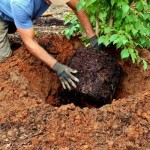How to Take Care of Your Lawn – pH Testing, Aeration & Overseeding
If you have cool season grass (e.g., fescue, ryegrass, bluegrass, etc.), now is the time that you really need to take those extra measures to ensure a beautiful lawn. And when I say extra measures, I mean those things beyond what most of us think of as the basics…like watering, mowing, and fertilizing. Specifically, what I’m talking about is:
-
- Testing the pH levels of your soil – Making sure that your soil has the right pH levels…so that the nutrients that your grass needs to grow lush and green are available.
- Aeration – Breaking up compacted soil so that air, water, and nutrients can get to your grass’ roots.
- Overseeding – Exactly what it sounds like – adding seed over your existing lawn to fill in bare spots and restore your lawn to a lusher state.
This past week I found a post called Why Aerate & Overseed? Why Test Soil pH? (isn’t that convenient!?!) that really fleshes out each of these extra. So I thought I’d pass it along. It’s by Matt Capalongo with Capscape…a landscape design & install firm out of Pittsburgh, PA. I think you’ll find it really helpful. (Thanks Matt…a great and timely post!) [Update: Matt’s post is no longer available.]
[Featured photo credit: Nejron Photo via Compfight cc]
![]()
Many people are looking to improve the quality of their lawns and aren’t sure how to go about it. There are many things you can do to get the desired results you want, but most don’t do the few simple things that can make the difference between an average lawn and a lush green lawn. Like the vegetables and flowers we plant, soil quality is huge to the health of grass. To get the lawn you desire, you must focus on the quality of the soil.
Testing the pH Levels of Your Soil
The first step is to test the pH levels of your soil. For optimal growth, the soil must be around 7.0. pH levels are measured on a scale from 1 – 14, with numbers below 7 being acidic (sour), and numbers above 7 being alkaline(sweet). If the soil is acidic, then you can apply lime or gypsum to neutralize the soil. On the other hand, alkaline soil can be neutralized by the application of sulfur.
There are some indicators that you can use to determine the pH levels of your lawn by just looking at your lawn. Crabgrass is one of the most common lawn weeds and it haunts many homeowners. It seeds itself and spreads in the spring, then sprouts out of the ground in summer. Crabgrass prefers acidic levels in the soil. Therefore, if you have lots of crabgrass, you most likely need to address the pH levels of the soil. Conversely, dandelions are an indicator that your soil has alkaline levels.
 [Note from Doug: To determine the pH levels of your soil, you could also purchase a host of different soil testers…like the one to the left. Or for even greater accuracy, send a soil sample to your local cooperative extension office – this would be something to really consider if you’re establishing your lawn for the first time or if it’s just been really tough getting your grass to grow. You can find your nearest cooperative extension office by clicking here.]
[Note from Doug: To determine the pH levels of your soil, you could also purchase a host of different soil testers…like the one to the left. Or for even greater accuracy, send a soil sample to your local cooperative extension office – this would be something to really consider if you’re establishing your lawn for the first time or if it’s just been really tough getting your grass to grow. You can find your nearest cooperative extension office by clicking here.]
Addressing the pH levels of your soil is one of the fundamental steps to increasing the quality of your lawn. Maintaining neutral pH levels will promote grass growth and eliminate most of your lawn weeds.
Aeration
The next step in acquiring the lawn you want is to observe the level of soil compaction. Soil can become compacted from many things (e.g., heavy machinery, people traffic, animal traffic). Soil compaction can be defined as the process in which stress is applied to the soil, causing it to be less likely to absorb air and water. Affected areas are more vulnerable to excessive water run-off and soil erosion. Air and water are also crucial to the growth of the roots of grass; therefore, affected areas also are likely to not foster a healthy lawn. Burrowing animals, which also help restore air and water to the soil by digging small penetrations through the soil, find dense soil as a difficult environment and another ingredient for a healthy lawn is lost.
In order to correct compacted soil, the process of lawn aeration must be completed. It involves making holes in the soil by poking or extracting a small plug of soil. This allows the air and water to penetrate the soil and make contact with the root system of the grass. This also allows the soil to absorb more water, preventing run off and erosion.
A lawn may be a good candidate for aeration if it:
-
- Gets heavy use — people and children often walk on it, pets and wildlife often walk on it.
- Was established as part of a newly constructed or renovated home or complex. Often the soil can become compacted by the traffic of construction equipment.
- Dries out easily. Compacted soil cannot absorb water.
[Note from Doug: By the way, aeration isn’t just a good thing for cool season grasses…you need to do it with your warm season grasses as well (e.g., Zoysia, Bermuda, centipede, St. Augustine, etc.). In fact, because of their propensity to accumulate a thick layer of thatch, some might argue it’s more important to consistently aerate warm season turfgrasses. However, instead of aerating in fall or early spring…as you would cool season grasses, you’d want to aerate warm season turfgrasses in the spring…just before they begin their rapid growing season in the summer.]
Overseeding
The final step that we will discuss in assuring a healthy lawn is overseeding. The concept of overseeding has been around for a while, but is still new to most home owners and property owners. Overseeding is simply the process of spreading seed over an existing lawn. Some say this step will improve the quality of your lawn more than anything else you will do. A blade of grass has a short lifespan, 6 to 8 weeks or 45 to 60 days. One of the methods of maintaining a healthy, green lawn is to keep the lawn young. Overseeding is the easiest way to do this. Not only will overseeding keep the lawn young, it will also fill in spots where the grass is thin.
If you follow these steps and complete once a year or once every two years, you are going to guarantee yourself that healthy lawn you’ve always wanted.
![]()
Matt…thanks again for all of this great information…really very helpful.
Alright ground redeemers…get out there and give your lawn what it needs to give you what you want. So quite literally, go redeem your ground!
Take care all,

You may also enjoy these posts from RYG ...
If you're not already subscribed to RYG and want to get periodic updates, links to new posts & other ground redeeming info ... just enter your email address below. Easy as that!








This was EXACTLY what we needed to hear. Our lawn was aerated last night. And I’ve now ordered a PH kit 🙂 The lawn is getting overseeded tomorrow. Thanks so much for the tips!
Perfect! And today’s rain is perfect timing! Glad it helped. Take care, D.
I have a neighbor who has a Bermuda lawn. I have tall fescue. His obviously creeps over and tries to take over my lawn. Is there a spray or product that I can use to keep the Bermuda at bay without hurting my fescue? Thanks!
Jason: Thanks for your question. First of all…let me as you, what are the growing conditions of your yard? I ask because Bermuda and Tall Fescue usually don’t perform well in the same environment. Regardless, there are some things you can do – unfortunately, moving in your direction (from Bermuda to Fescue) will prove more difficult than the other direction (Fescue to Bermuda). It may take several seasons to eliminate the Bermuda and then will require consistent maintenance. Here is a link that provides a list of herbicides…I thought you might find it helpful: http://www.garden-counselor-lawn-care.com/killing-bermuda-grass.html.
All that said, depending on where the connection point is b/w your 2 spaces, the best solution may actually be in the design of your yard. In other words, it may make sense to create a barrier or extend a flower bed where the Fescue and Bermuda are now meeting. Just a thought. If you’d like to send me a cpl of pics I’ll take a look at them and let you know my thoughts.
Take care, D.
Great tips! Thanks for sharing!